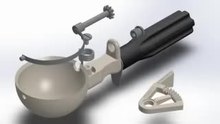Ice cream scoop
An ice cream scoop is used to portion ice cream . It is mostly used in ice cream parlors in order to achieve a constant size and an appealing presentation of the ice cream .
Ice scoops that are in constant use are regularly submerged in water to clean, warm and wet them.
Designs
The part of an ice cream scoop that comes into contact with the ice cream can be made of metal, silicone or other materials. Since ice cream easily freezes to metal or sticks to other substances, there are different methods of removing the ice cream from the scoop.
Mechanical portioning
A mechanical ice cream scoop has a circular, hemispherical bowl and a pincer handle. A small, narrow shovel is moved in the bowl with the pincer handle, which mechanically removes the ice cream from the bowl. This enables the ice cream portion to be conveniently draped.
Alternatively, a double spoon ejects the ball.
Thermal portioning
A thermal ice cream scoop has an approximately cylindrical handle, the inside of which is made of a material with good thermal conductivity , for example a special gel or metal. The hemispherical front part also heats up due to the body temperature of the user's hand, and the ice ball comes off more easily. As the scoop is heated, it glides more easily through the ice cream mass. Removing the portion from the ice cream mass is less strenuous compared to the household variant of “cutting up” the ice in the ice cream container. The cleaning of the portioner is easier than with the mechanical variant, as there are no mechanics and therefore no places where residues could stick or where the rinsing water cannot reach. The design of the thermal portioner is therefore preferred in professional use.
The prototype thermal ice cream scoop was designed in 1933 by Sherman Kelly of Toledo, Ohio under the name The Ice Scoop . The prototype is in the permanent collection of the Museum of Modern Art in New York City. The model is still made in the USA today.
Scraper or spatula
Using a simple scraper or spatula takes more practice than the other designs to drape portions of ice cream onto the ice cream cone .
hygiene
Since ice cream scoops have to be rinsed after use in order to avoid mixing different types of ice cream, many restaurateurs use a container filled with water. Standing water is often used here.
The following options are available to keep the germ load as low as possible:
- Use of a portioning shower with fresh water supply
- frequent (hourly) changing of the scoop water
- Add one percent citric acid to the rinsing water
Device sizes
| Diameter in mm | 30th | 35 | 40 | 43 | 45 | 49 | 56 | 67 | 70 |
|---|---|---|---|---|---|---|---|---|---|
| Contents of the hemisphere in liters | 1/100 | 1/70 | 1/60 | 1/50 | 1/40 | 1/30 | 1/20 | 1/12 | 1/10 |
49 mm ice cream scoops are common, i.e. H. that with it 30 hemispheres can be cut out of one liter of ice. If 3 whole scoops are calculated for 1 person, then 1 liter of ice is sufficient for 5 people, i.e. H. 200 ml per person.
Individual evidence
- ↑ ice cream scoop hygiene , Eisinvest GmbH.



